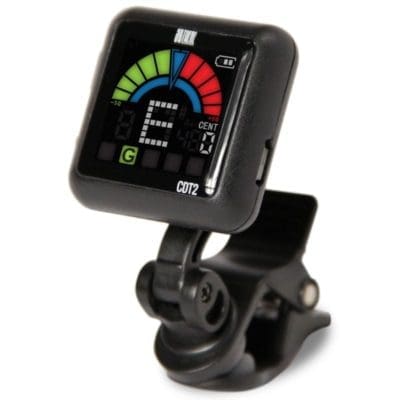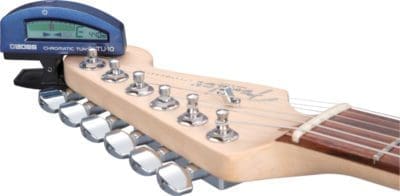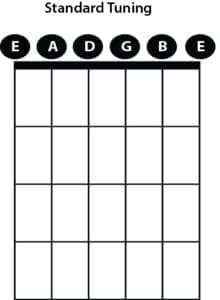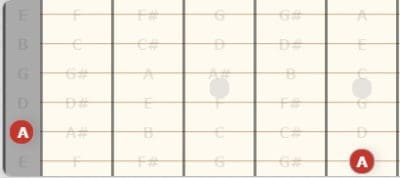Last update 5/2/2024
Let’s talk about how to tune your guitar. We shall frame up a pretty familiar scenario for many beginning guitar players: You walk into your local music store to do a little guitar shopping. Some more prominent retailers practice letting customers pull a guitar off the wall. (They are typically hanging on a rack). Once you have it down, you can’t help but notice how cool it is…how good it feels under your fingers…
Table of contents
You then plug it into an amp (if good acoustic guitars are your thing, then sit down and prepare to play). You go to hit a chord, and instead of complete sonic goodness, it sounds terrible. Like cats-fighting-in-a-bag-type terrible…actually, like nails-on-a-chalkboard-type terrible.
How to Tune Your Guitar
But how can that be? You’ve picked one of the best guitars you’ve ever come across to check it out. It just can’t be the guitar. Well…maybe it is. You, my friend, have just tried to play the guitar that is horribly out of tune. And that won’t do!
We are going to expand on the topic of tuning. A few blog installments here because knowing about tuning your guitar is a skill that players of all levels must master.
At the same time, guitar tuning may not be all that hard. Having some solid knowledge about how it all works will be invaluable for your playing and understanding of the instrument.
Having a properly tuned guitar is probably one of the most, if not the most, fundamental things for playing the guitar properly. The tuning process can be a bit of a mystery for most beginners. So let’s try to clear some things up, shall we?
“Most people can do what I do – they can do guitar solos – but they can’t do a good, hard rhythm guitar and be dedicated to it.” Angus Young
It’s the most straightforward definition: tuning your guitar means the following. All of the strings sound correct when plucked ‘open’ (meaning: not fretting any notes). That is accomplished by applying the right amount of tension to each string.
It’s all about tension.
A guitar is a few pieces of wood with long wires. It can’t get much simpler than that. Each string must have some tension for your guitar to sound as it should.
Most guitar strings are made of very thin lengths of tough steel wire. So without that tension, the string won’t vibrate at the correct frequency needed to sound the right note.
How to change the tension of your guitar strings
Look at the headstock of your guitar (found at the end of the neck, which is farthest away from you). There you will see ‘tuning machines’ – one for each string.


Tuning machines are essentially small gearboxes you thread through a guitar string’s end.
The other end is attached to the guitar at the bridge, close to where your picking hand strikes the strings.
Turning the button on the tuning machine will allow you to increase or decrease string tension.
How to tune a guitar – Sharp, flat, or perfectly in tune?
A string’s note varies with how much tension is applied when you strike it. The higher the tension, the higher the note will sound. (t before, the lower the tension, the lower the note will be.
A guitar string will always be in one of three states when you begin tuning:
Sharp – too much string tension results in a higher pitch note than it should be when properly tuned.
Flat – the note will be of a lower pitch than intended, meaning more string tension must be applied.
In tune – the string tension is correct where it should be (given its thickness and the material it is made out of). This results in the string sounding the exact note you are trying to tune it to.
But how much tension should an ‘in tune’ guitar string have?
There are too many factors for an absolute answer to that. Strings can come in different gauges or thicknesses, considerably affecting them. Also, depending on the type of guitar, you may be using strings made from another material altogether—for example, nylon strings on a classical guitar.
We know what you’re thinking: “What’s with all of this science stuff, and what does it have to do with playing the guitar?!?” Yeah…well, there’s no doubt that a level of physics goes into all of this. Fear not; however, there will not be a test at the end of this lesson!
Here’s where things get a bit easier to understand, though. When it comes to tuning your guitar, you don’t need to measure the tension for each string.
All you have to do is ensure the intended note sounds right. Is the note flat? Tighten the string up a bit to raise the pitch. Sharp? Loosen things up. All in all, it is that simple.
How to tune a guitar -the best way
Two methods are used: using a guitar tuner and tuning manually (also called ‘tuning by ear). Yeah, you can tune your guitars online if you have internet access at the time.
Our overwhelming preference is tuning a guitar using a must-have accessory called a tuner. Your results will typically be more accurate.
That being said, there are some benefits to learning how to tune manually. Ultimately, it may be best for a guitar player to use either method.


Recap
Tuning your guitar is an essential skill that is a must-have for every guitar player.
Your guitar won’t sound right if it’s not in tune. So it’s imperative to tune your guitar correctly before each time you practice, every time you have a gig or every recording session you may have.
While the science behind tuning a guitar can seem a little daunting, you don’t have to concern yourself with it all that much.
In the end, the thing that needs to be done is to ensure each string produces the correct note.
You’ll be glad to know that the science/physics-type stuff is over! Yeah, we know that may have been a bit on the dull side. However, knowing what tuning your guitar is all about isn’t bad.
We have already pointed out two main ways to tune your guitar: using a tuner and doing it manually.
Now, we will use a tuner and explain why it may be the best choice over manual tuning.
Furthermore, we shall discuss the different types of available tuners (while also noting the pros and cons of each).
What is a guitar tuner?
A guitar tuner is a device that takes the vibrations from a plucked string and determines whether or not it is in tune. We feel that using a tuner is the best way to go over manual tuning. That’s for several reasons:
Most tuners give you a quick visual indicator of whether you are in tune or not. With a tuner, you will have some screen or another way of letting you know that you are either sharp, flat or in tune.
“I tried to connect my singing voice to my guitar and my guitar to my singing voice. Like the two was talking to one another.” B. B. King
There’s typically not a lot of guesswork. Some of them have displays that change color when you’re right where you need to be. They are straightforward to use and probably the best choice for a beginner.
Tuning an electric guitar
All you have to do with an electric guitar is plug your instrument cable into it. Turn up the volume on your guitar and pluck a note. The signal goes into the tuner. It pretty much immediately tells you whether you need to increase or decrease string tension.


Tuning an acoustic guitar
With an acoustic guitar that doesn’t have an electric capability. However, tuners can be found with small microphones in them. Set the tuner close to the guitar and tune away.
A good majority of tuners can be had for little money.
Tuners, like just about anything, do have a price range. Higher-end models can run several hundred dollars. But most players don’t need that kind of capability or exacting accuracy.
These days, a simple tuner can be had for under $20. However, some middle-of-the-road models are approaching the $100 threshold.
They have a level of accuracy that is much higher than manual tuning.
Let’s face it – no matter how well your ear is developed. You most likely aren’t good enough to beat an electrical circuit. You are much more likely to tune faster and more accurately using a tuner than manually.
That’s especially true in some live environments. Background noise can make it hard to discern individual notes. However, tuners filter out that noise for the most part.
Types of guitar tuners
There are several kinds of guitar tuners, each with its strengths and weaknesses. It’s worth your time to take a look at them all. That will let you pick out the one that will work best for your needs.
Clip-On Tuners
A clip-on tuner is a simple unit – relatively inexpensive for the most part. That does exactly as the name implies. The tuning unit itself is attached to a clip that mounts with a spring mount to the headstock of your guitar. As you tune, the string vibrations are channeled through the mount to the tuner.
There is a small display that tells you where you are at. That makes them well-suited for either electric or acoustic guitars.
“When you tune your guitar in a different way, it lends itself to a new way of looking at your songwriting”.Sheryl Crow
The benefits of a clip-on tuner are the low price and ease of use.
One of the downsides is that you typically have to take them off before you start playing, especially in a live situation where you may be moving around a bit.
The spring in the clip is reasonably strong but not necessarily robust enough when planning to ‘rock and roll all night and party every day.’
Pedal tuners


Take the guts of a guitar tuner circuit and put it into a stomp-box-sized enclosure. That’s a pedal tuner. It’s not uncommon for live guitarists to have some pedal board or array of loose effects.
However, having a tuner as the first pedal in the signal chain allows quick and easy tuning.
Stepping on a pedal tuner turns it on, where it will completely mute the signal and allow you to tune as you need. That’s beneficial in live situations because who wants to hear your tune-up?
They also tend to have bright displays on them for dark gigging environments. They are super easy to see onstage, also.
On the flip side, pedal tuners are usually a bit more expensive than a clip-on unit. But, in our assessment, paying a little more for the benefits that a pedal tuner allows may be worth every penny.
Additionally, they usually do not have a microphone.
However, they do not play well with acoustics without any pickup. Hand-held units Back in the day, hand-held tuners were close to the only option you may have had.
Before, technology had advanced to where it is today. These tuners had a needle that would move based on the note frequency.
They tended to be somewhat tricky to use. This happened because the needle would tend to bounce around and not be very stable.
They have evolved to be more ‘screen-based,’ with the needle being replaced by some LCD screens.
Getting rid of the mechanical workings tends to make them more manageable. However, we honestly would recommend against using them. Unplugging your guitar from your signal chain to plug it into a tuner is just plain inconvenient. Mainly when playing live, where you need to tune up quickly between songs.
Smartphone tuning apps


There’s an app for everything these days. You bet there are many available tuning apps (both free and with a small cost). Open the app and tune it to your heart’s desire. Sounds like a winner, right?
Well…not really. Sure, you can’t beat the price for the most part. But there are enough downsides. We would not typically suggest using a tuning app unless you have no objective other choices.
They can tend to be unstable at best. It all depends on the microphone within your phone for the signal output.
The engines that drive the frequency analysis may not be that great. Add all of that up, and it can lead to inconsistent results.
The tuner types a recap. Overall, using a guitar tuner in some form is usually the best way to get your guitar tuned as fast and as accurately as you can.
They are reasonably innovative devices that can let you save time tuning and spend more time playing!
That being said, you need to look at the good and bad points for each tuner type. A tuner that works well for one guitarist may not be the best option for another.
You should investigate all of the options available and make the best choice for your needs.
We will detail how to tune your guitar manually in the next installment of this series on guitar tuning. There are a few different ways to go about it. It’ll be right for you to have that knowledge in your back pocket if you ever find yourself in a situation where a good guitar tuner isn’t available.
Manual tuning
Up to this point, we went over what it means to tune your guitar (that is, how string tension relates to note pitch), and we also touched base on the different types of guitar tuners that are available.
On this go-around, we will discuss the process of manual tuning. Truthfully, this is a bit of an ‘old school’ way of doing things.
That being said, it was pretty much how things were done before guitar tuners got to the point of being so accurate and easy to use (while having a pretty low price point for the most part).
Before we dive in, though, a few points and concepts need to be discussed.
Standard guitar tuning


The process we are going to review is geared toward standard tuning. Standard tuning is a particular set of notes that each string is tuned to and used extensively.
Almost every song you’ve heard or tried to play uses standard tuning, and it is the basis for how most people learn to play guitar.
The notes for each string in standard tuning are: 6th string (thickest) – E
5th string – A
4th string – D
3rd string – G
2nd string – B
1st string (thinnest) – E (two octaves above the low E on the 6th string) Here’s a side note – as you gain more guitar experience.
You may think of different note setups for each string, called ‘alternate tunings.’ They can significantly benefit from getting a tonal color that you can’t get from standard tuning. Chord fingerings can be simplified.
The alternate tuning is a fairly broad topic all to itself – plus, it can be unclear to many beginners.
Standard Tuning
However, we are going to stick exclusively with standard tuning for now. So, what is manual tuning? The guitar is unique in that there are many ways to play the same note with the same pitch on different strings.
This is unlike a more linear instrument like the piano. Each key represents a specific note on a piano that can’t be played anywhere else on the keyboard.
“At a young age, I thought, ‘Wow, that fiddle thing, that’s pretty cool. That mandolin is great. These drums, I like these drums… ‘ They were Indian drums. And I was saying, ‘But that guitar. That guitar. Girls are going to like that guitar.” Robbie Robertson
In its purest form, manual tuning is a series of steps where you use notes from other strings to compare to the string you are trying to tune. For example, the following notes are all the same E note:


Keep this concept in mind as we move along. But before we get into the details of the manual tuning process.
A few points must be understood to make your tuning as accurate as possible. Lack of a ‘true’ reference notes
One thing that is simply awesome about a guitar tuner over manual tuning.
That gives you an accurate reference for each note you try to tune to. Using a tuner and a dead-on tune, you will play with other instruments at the absolute correct pitch.
This is particularly important if you’re playing with, for example, a keyboardist.
As we described earlier, manual tuning uses similar notes from other strings to allow you to tune all six strings to be in tune relative to each other. It’s important to understand that your starting note (typically the low E) is slightly sharp or somewhat flat.
Then, you won’t be in tune with other instruments that are indeed tuned to standard pitch. Sure, you may sound perfect playing all by yourself, but the minute you start to go along with other instruments, it will be painfully clear that you aren’t in tune with the rest of the band.
How good is your ear?
As you progress in your playing, you’ll most likely develop what is called ‘your ear.’ What does that mean? As far as manually tuning your guitar goes, it refers to the ability to tell when two notes produce the same pitch.
It seems like it should be pretty easy to do that, right? Well, that can be a little tough for beginners to do consistently.
You may be surprised at how hard it can be to hear the differences in pitch between two notes at the start of your playing career. And since manual tuning is all about telling when two notes (played on two different strings) are identical.
Having a well-developed ‘ear’ is a skill that must be mastered before being as accurate as possible.
We aren’t mentioning these things to prevent you from learning the manual tuning process. On the contrary, there are times when you may have no other choice.
Undoubtedly, at some point in your playing career, you’ll have forgotten your tuner, or the battery is the one you do have may have gone dead. Knowing how to tune manually will be your saving grace in these cases.
How to manually tune your guitar
First, attempt to get a good reference note for the low E note (played on the 6th string). You can get this by using your ‘ear’ with a reference note from a piano, a recording, or even a note generator that can be found with many free tuning apps.
As we discussed earlier, having an accurate reference at the start of the process is essential. So, do your best to get that low E as perfect as possible.
“I learned to tune a guitar by ear. That method has served me pretty well.”
Charley Pride: Once you have your 6th string tuned to that perfect E note, fret the 6th string at the 5th fret. That will produce an A note. It just happens to be the same A note that should ring out when you play the 5th string open. See the diagram below:


Here’s a tip – when you play the A note on the sixth string, let it ring out while playing the open 5th string. That will allow you to compare the two notes.
You can then tune the 5th string to where the notes are identical. Simple enough, right? In essence, it is. And getting the rest of your guitar tuned up uses the same process.
Now that you’re A string is tuned correctly, play the D note at the 5th fret of the A string. That D note is – you guessed it. The same D note should sound when the 4th string is tuned correctly.
Continue tuning
From there, go to the 5th fret of the D string. That’s a G; you can use that note to tune up the 3rd string.
Next is a little bit of a twist, but not that much – once your 3rd string is tuned. You’re ready to adjust your 2nd string.
Don’t go to the 5th fret of the 3rd string. You have to play the B note on the 4th fret of the 3rd string instead of getting the open 2nd string.
It’s a minor difference from the other strings, but that’s how the process must be followed.
Last is the 1st string. You can return to the 5th fret of the 2nd string to get that final E note to tune to. To help visualize things better, the entire process can be summed up by looking at the diagram below.
As you can see, all identical notes are the same color (the two red A notes are the same). The two green E notes are the same, etc.
Hopefully, you can see how important it is to ensure that the first low E note (playing the 6th string open) is correct because everything else is based on that starting point.
Conclusion
Tune your guitar correctly is a skill that has to be mastered before you can seriously consider lessons to play the guitar. The vast majority of guitarists use standard tuning.
That set of notes can easily be obtained using a good guitar tuner. Manual tuning is a process that may not be as easy as using a tuner.
However, there might be concerns over how accurate it is.
But you really should learn how to tune using both methods. You don’t want to find yourself in a position where a guitar tuner isn’t available and you don’t know what else to do.
Over time, you’ll also be able to tell when you are out of tune. The string (or strings) that aren’t correctly tuned will make your guitar not sound ‘right.’ Keeping Your guitar in tune will make your playing sound as good as possible.
Transparency disclosure: Some of the links in this post are affiliate links, meaning that I may earn a commission if you click on a link and make a purchase. This commission comes at no extra cost to you. We only recommend products and services that I believe are helpful and valuable, and we never let the potential for a commission influence our recommendations.
Amazon top guitar tuners.



